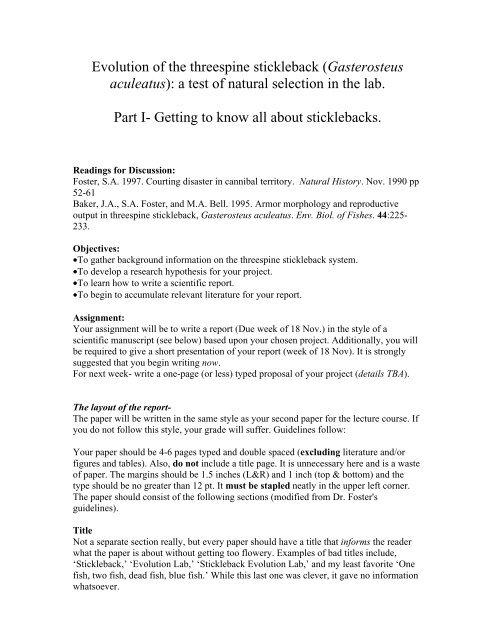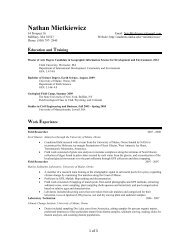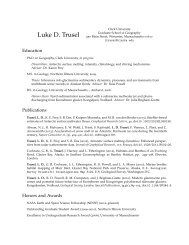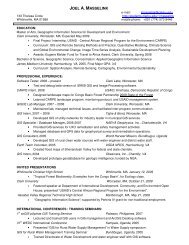Evolution of the threespine stickleback (Gasterosteus aculeatus): a ...
Evolution of the threespine stickleback (Gasterosteus aculeatus): a ...
Evolution of the threespine stickleback (Gasterosteus aculeatus): a ...
You also want an ePaper? Increase the reach of your titles
YUMPU automatically turns print PDFs into web optimized ePapers that Google loves.
<strong>Evolution</strong> <strong>of</strong> <strong>the</strong> <strong>threespine</strong> <strong>stickleback</strong> (<strong>Gasterosteus</strong><br />
<strong>aculeatus</strong>): a test <strong>of</strong> natural selection in <strong>the</strong> lab.<br />
Part I- Getting to know all about <strong>stickleback</strong>s.<br />
Readings for Discussion:<br />
Foster, S.A. 1997. Courting disaster in cannibal territory. Natural History. Nov. 1990 pp<br />
52-61<br />
Baker, J.A., S.A. Foster, and M.A. Bell. 1995. Armor morphology and reproductive<br />
output in <strong>threespine</strong> <strong>stickleback</strong>, <strong>Gasterosteus</strong> <strong>aculeatus</strong>. Env. Biol. <strong>of</strong> Fishes. 44:225-<br />
233.<br />
Objectives:<br />
•To ga<strong>the</strong>r background information on <strong>the</strong> <strong>threespine</strong> <strong>stickleback</strong> system.<br />
•To develop a research hypo<strong>the</strong>sis for your project.<br />
•To learn how to write a scientific report.<br />
•To begin to accumulate relevant literature for your report.<br />
Assignment:<br />
Your assignment will be to write a report (Due week <strong>of</strong> 18 Nov.) in <strong>the</strong> style <strong>of</strong> a<br />
scientific manuscript (see below) based upon your chosen project. Additionally, you will<br />
be required to give a short presentation <strong>of</strong> your report (week <strong>of</strong> 18 Nov). It is strongly<br />
suggested that you begin writing now.<br />
For next week- write a one-page (or less) typed proposal <strong>of</strong> your project (details TBA).<br />
The layout <strong>of</strong> <strong>the</strong> report-<br />
The paper will be written in <strong>the</strong> same style as your second paper for <strong>the</strong> lecture course. If<br />
you do not follow this style, your grade will suffer. Guidelines follow:<br />
Your paper should be 4-6 pages typed and double spaced (excluding literature and/or<br />
figures and tables). Also, do not include a title page. It is unnecessary here and is a waste<br />
<strong>of</strong> paper. The margins should be 1.5 inches (L&R) and 1 inch (top & bottom) and <strong>the</strong><br />
type should be no greater than 12 pt. It must be stapled neatly in <strong>the</strong> upper left corner.<br />
The paper should consist <strong>of</strong> <strong>the</strong> following sections (modified from Dr. Foster's<br />
guidelines).<br />
Title<br />
Not a separate section really, but every paper should have a title that informs <strong>the</strong> reader<br />
what <strong>the</strong> paper is about without getting too flowery. Examples <strong>of</strong> bad titles include,<br />
‘Stickleback,’ ‘<strong>Evolution</strong> Lab,’ ‘Stickleback <strong>Evolution</strong> Lab,’ and my least favorite ‘One<br />
fish, two fish, dead fish, blue fish.’ While this last one was clever, it gave no information<br />
whatsoever.
Abstract<br />
A one-paragraph summary <strong>of</strong> <strong>the</strong> paper excluding citations. Write this last.<br />
Introduction<br />
Here you set up <strong>the</strong> issue and review <strong>the</strong> background logic and literature. If you<br />
are exploring morphological evolution in <strong>stickleback</strong> (that is, only worrying about this<br />
fish, not o<strong>the</strong>r organisms) you might introduce <strong>the</strong> variety <strong>of</strong> selective regimes<br />
<strong>stickleback</strong> encounter (e.g., ecological components) and what is expected to occur to<br />
<strong>stickleback</strong> shape in those conditions citing <strong>the</strong> relevant literature. You <strong>the</strong>n would<br />
explain that <strong>the</strong>re exists X possible explanations (alternative hypo<strong>the</strong>ses) and that you<br />
will test one (or all) <strong>of</strong> those by doing…..(whatever it is that you are doing without going<br />
into detail about <strong>the</strong> methods).<br />
Methods<br />
This is a clearly written account <strong>of</strong> what you did (in <strong>the</strong> past tense). Try to avoid<br />
writing in <strong>the</strong> first person. That is, instead <strong>of</strong> saying, "I weighed 30 <strong>stickleback</strong> each from<br />
4 populations to <strong>the</strong> nearest .01g" you should say something akin to, "Thirty <strong>stickleback</strong><br />
from each <strong>of</strong> four populations were weighed to <strong>the</strong> nearest .01g." It should be in enough<br />
detail that o<strong>the</strong>rs could repeat your procedures. It should be concise though and not filled<br />
with needless detail. For example, even though you will take X number <strong>of</strong> fish from quart<br />
jars supplied by me, you would not write, "Fish were removed from quart jars and placed<br />
onto paper towels" or "Specimens were supplied by <strong>the</strong> TA." This is unnecessary detail.<br />
Results<br />
Again, this is a straight-forward account <strong>of</strong> your results. Here you present <strong>the</strong><br />
outcome <strong>of</strong> your analyses using full sentences and figures/tables without interpretation.<br />
Do not include raw data (<strong>the</strong>se are raw data- not results). Any figures or tables should be<br />
clearly labeled included a description <strong>of</strong> what <strong>the</strong> figure/table is summarizing. Don't tell<br />
<strong>the</strong> reader what you think <strong>the</strong> data mean. That information is for <strong>the</strong> next section. See any<br />
research article in <strong>the</strong> journal <strong>Evolution</strong> to learn how <strong>the</strong> Results section should written.<br />
Discussion<br />
In this section you interpret your results in light <strong>of</strong> your original hypo<strong>the</strong>sis which<br />
was set forth in <strong>the</strong> Introduction. This should not just be a restatement <strong>of</strong> your results.<br />
You must syn<strong>the</strong>size and compare ideas. You can conclude with your evaluation <strong>of</strong> <strong>the</strong><br />
most plausible explanation(s), explaining your interpretation carefully. DO NOT SKIMP<br />
ON THIS SECTION. IF YOU JUST RESTATE WHAT WAS ALREADY STATED,<br />
SHOWING NO EVIDENCE OF THOUGHT AND EFFORT, YOU WILL NOT<br />
RECEIVE FULL CREDIT.<br />
Literature Cited- List all <strong>of</strong> <strong>the</strong> literature you cite in <strong>the</strong> text. All citations should appear<br />
in <strong>the</strong> text as, for example, "<strong>the</strong> <strong>threespine</strong> <strong>stickleback</strong> is holarctically distributed in<br />
nearshore marine and fresh water habitats (Bell & Foster 1994)." If <strong>the</strong>re is just one
author indicate for example (Foster 1998), if <strong>the</strong>re are more than two, (Baker et al. 1998).<br />
All citations in <strong>the</strong> literature cited section must have been used in <strong>the</strong> text in support <strong>of</strong> a<br />
statement you make. Be certain <strong>the</strong> paper supports <strong>the</strong> observation (be accurate in<br />
attribution). Always cite sources <strong>of</strong> ideas or data (or you are committing plagiarism). In<br />
typing <strong>the</strong> literature cited section <strong>of</strong> <strong>the</strong> paper you should follow <strong>the</strong> format in <strong>the</strong> journal<br />
<strong>Evolution</strong> which you will find in <strong>the</strong> science library. Look at papers in this journal should<br />
you have questions about how to cite literature properly in <strong>the</strong> text. You should have no<br />
less than 6 primary sources for this paper.





